Size-Induced Constraint Effects on Crack Initiation and Propagation Parameters in Ductile Polymers
Abstract
1. Introduction
2. Theory and Calculation
2.1. Constraint Effects in SENB Specimens
2.1.1. Determination of Constraint Level in the Crack Initiation Phase via the Material Key Curve
2.1.2. Changing the Constraint Level in the Crack Growth Phase by Testing Side-Grooved Specimens
2.2. Evaluation of Crack Initiation and Crack Growth Parameter
2.2.1. Determination of the J–R Curve
2.2.2. Determination of the Crack Initiation Parameters
3. Materials and Methods
3.1. Specimen Scale-Up
3.2. Material
3.3. Specimen Preparation
3.4. Testing Procedures
4. Results and Discussion
4.1. Evaluation of Specimen Constraint
4.1.1. Applicability of Load Separation Principle
4.1.2. Determination of Specimen Constraint during Crack Initiation via Material Key Curve
4.2. Crack Growth Resistance Curve
4.2.1. Crack Growth Resistance Curve from the Multispecimen Procedure
4.2.2. Determination of Specimen Constraint during Crack Propagation via Testing of Side-Grooved Specimens
4.3. Fracture Initiation Parameters
4.3.1. Initiation Toughness Parameter Determined from the J–R Curve
4.3.2. Initiation Toughness Parameter Jini
4.3.3. Comparison of Crack Initiation Parameters
5. Conclusions
- J0.2 (apparent), which is based on the technological evaluation of the J–R curve [13] and displayed slowly increasing initiation values for specimens with W values of 10 to 40 mm.
- Jbl (apparent), which is also based on the technological evaluation of the J–R curve [13] and displayed the lowest initiation values and a similar behavior to J0.2.
- Jini, which is based on the initiation time, tini, and displayed increasing crack initiation values with increasing specimen size where small deviations were detected for changing constraint states.
- JI,lim, which is based on the ESIS TC4 LS method and displayed similar results as Jini, thus supporting the size-dependent fracture initiation behavior (initiation parameters increase with increasing specimen size).
Author Contributions
Funding
Institutional Review Board Statement
Informed Consent Statement
Data Availability Statement
Acknowledgments
Conflicts of Interest
References
- Anderson, T.L. Fracture Mechanics: Fundamentals and Application; CRC Press—Taylor & Francis Group: Boca Raton, FL, USA, 2005. [Google Scholar]
- Donoso, J.R.; Landes, J.D. The role of constraint on the calibration functions for the prediction of ductile fracture behavior in structural components. Int. J. Fracture 1993, 63, 275–285. [Google Scholar] [CrossRef]
- Donoso, J.R. Common format for developing calibration curves in elastic plastic fracture mechanics. Eng. Fract. Mech. 1994, 47, 619–628. [Google Scholar] [CrossRef]
- Zhu, X.-K.; Joyce, J.A. Review of fracture toughness (G, K, J, CTOD, CTOA) testing and standardization. Eng. Fract. Mech. 2012, 85, 1–46. [Google Scholar] [CrossRef]
- Frontini, P.; Santarelli, E. The Effects of Specimen Size and Testing Conditions on Fracture Toughness Evaluation of Polypropylene Homo polymer. Polym. Eng. Sci. 2001, 41, 1803–1814. [Google Scholar]
- Che, M.; Grellmann, W.; Seidler, S. Crack resistance behavior of polyvinylchloride. J. Appl. Polym. Sci. 1997, 64, 1079–1090. [Google Scholar] [CrossRef]
- Gosch, A.; Arbeiter, F.J.; Agnelli, S.; Berer, M.; Pinter, G.; Baldi, F. J-testing of polymers via the load separation criterion based ESIS TC4 procedure: Effect of the specimen size. Polym. Test. 2020, 89, 106637. [Google Scholar] [CrossRef]
- Agnelli, S.; Baldi, F. A testing protocol for the construction of the load separation parameter curve for plastics. ESIS TC4 Commun. 2015, 1–7. [Google Scholar]
- Ernst, H.; Paris, P.C.; Landes, J.D. Estimations on J-Integral and tearing modulus T from a single specimen test record. Am. Soc. Test. Mater. 1981, 476–502. [Google Scholar]
- Hale, G.E. (Ed.) An Evaluation of the ESIS Protocol for Measurement of the J-Fracture Toughness of Thermoplastics; European Structural Integrity Society: Darmstadt, Germany, 1995. [Google Scholar]
- Agnelli, S.; Baldi, F.; Blackman, B.R.K.; Castellani, L.; Frontini, P.M.; Laiariandrasana, L.; Pegoretti, A.; Rink, M.; Salazar, A.; Visser, H.A. Application of the load separation criterion in J-testing of ductile polymers: A round-robin testing exercise. Polym. Test. 2015, 44, 72–81. [Google Scholar] [CrossRef]
- Baldi, F.; Agnelli, S.; Andena, L.; Blackman, B.R.K.; Castellani, L.; Frontini, P.M.; Kučera, J.; Laiarinandrasana, L.; Pegoretti, A.; Salazar, A.; et al. Determination of the Fracture Resistance of Ductile Polymers: The ESIS TC4 Recent Experience. Matls. Perf. Charact. 2020, 9, 20190175. [Google Scholar] [CrossRef]
- Hale, G.E.; Ramsteiner, F. (Eds.) J-Fracture Toughness of Polymers at Slow Speed; Elsevier: Oxford, UK, 2001. [Google Scholar]
- Frontini, P.M.; Fasce, L.A.; Rueda, F. Non linear fracture mechanics of polymers: Load Separation and Normalization methods. Eng. Fract. Mech. 2012, 79, 389–414. [Google Scholar] [CrossRef]
- Bernal, C.R.; Cassanellli, A.N.; Frontini, P.M. A Simple Method for J-R Curve Determination in ABS Polymers. Polym. Test. 1995, 14, 85–96. [Google Scholar] [CrossRef]
- Bernal, C.R.; Montemartini, P.E.; Frontini, P.M. The Use of Load Separation Criterion and Normalization Method in Ductile Fracture Characterization of Thermoplastic Polymers. J. Polym. Sci. Part B Polym. Phys. 1996, 34, 1869–1880. [Google Scholar] [CrossRef]
- Salazar, A.; Rodriguez, J. The use of the load separation parameter Spb method to determine the J–R curves of polypropylenes. Polym. Test. 2008, 27, 977–984. [Google Scholar] [CrossRef]
- Baldi, F.; Ricco, T. High-rate J-testing of toughened polyamide 6/6: Applicability of the load separation criterion and the normalization method. Eng. Fract. Mech. 2005, 72, 2218–2231. [Google Scholar] [CrossRef]
- Baldi, F.; Agnelli, S.; Rico, T. On the determination of the point of fracture initiation by the load separation criterion in J-testing of ductile polymers. Polym. Test. 2013, 32, 1326–1333. [Google Scholar] [CrossRef]
- Agnelli, S.; Baldi, F.; Castellani, L.; Pisoni, K.; Vighi, M.; Laiarinandrasana, L. Study of the plastic deformation behaviour of ductile polymers: Use of the material key curves. Mech. Mater. 2018, 117, 105–115. [Google Scholar] [CrossRef]
- Agnelli, S.; Baldi, F.; Riccò, T. The load separation criterion in elastic-plastic fracture mechanics: Rate and temperature dependence of the material plastic deformation function in an ABS resin. In Proceedings of the AIP Conference Proceedings, Ischia, Italy, 10–14 June 2012; pp. 114–116. [Google Scholar]
- Baldi, F.; Agnelli, S.; Ricco, T. On the applicability of the load separation criterion in determining the fracture resistance (JIc) of ductile polymers at low and high loading rates. Int. J. Fracture 2010, 165, 105–119. [Google Scholar] [CrossRef]
- Sharobeam, M.H.; Landes, J.D. The load separation criterion and methodology in ductile fracture mechanics. Int. J. Fracture 1991, 47, 81–104. [Google Scholar] [CrossRef]
- Sharobeam, M.H.; Landes, J.D. The load separation and npl development in precracked specimen test records. Int. J. Fracture 1993, 59, 213–226. [Google Scholar]
- Gosch, A.; Arbeiter, F.J.; Berer, M.; Pinter, G. Comparison of J-integral methods for the characterization of tough polypropylene grades close to the glass transition temperature. Eng. Fract. Mech. 2018, 203, 2–17. [Google Scholar] [CrossRef]
- Salazar, A.; Rodrigez, J.; Martinez, A.B. The role of notch sharpening on the J-fracture toughness of thermoplastic polymers. Eng. Fract. Mech. 2013, 101, 10–22. [Google Scholar] [CrossRef]
- Lach, R.; Krolopp, T.; Hutar, P.; Grellmann, W. Influence of the interface and the additional layer on the stable crack propagation through polyolefin bilayered structures. Procedia Mater. Sci. 2014, 3, 867–872. [Google Scholar] [CrossRef][Green Version]
- Lach, R.; Seidler, S.; Grellmann, W. Resistance Against the Intrinsic Rate of Fracture Mechanics Parameters for Polymeric Materials Under Moderate Impact Loading. Mech. Time Depend. Mater. 2005, 9, 103–119. [Google Scholar] [CrossRef]
- Lach, R.; Grellmann, W. Time- and Temperature-Dependent Fracture Mechanics of Polymers: General Aspects at Monotonic Quasi-Static and Impact Loading Conditions. Macromol. Mater. Eng. 2008, 293, 555–567. [Google Scholar] [CrossRef]
- Kolednik, O. A simple model to explain the geometry dependence of J-Da curves. Int. J. Fracture 1993, 63, 263–274. [Google Scholar] [CrossRef]
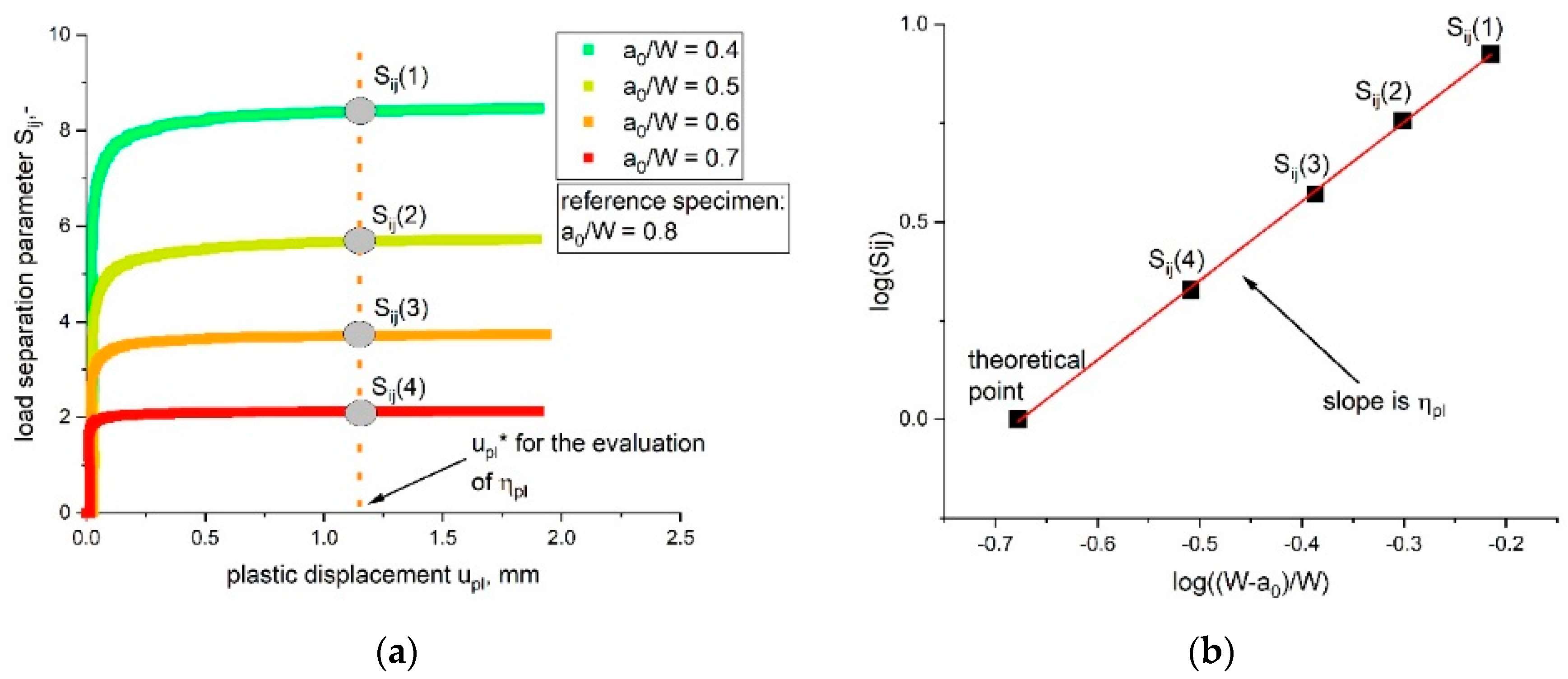
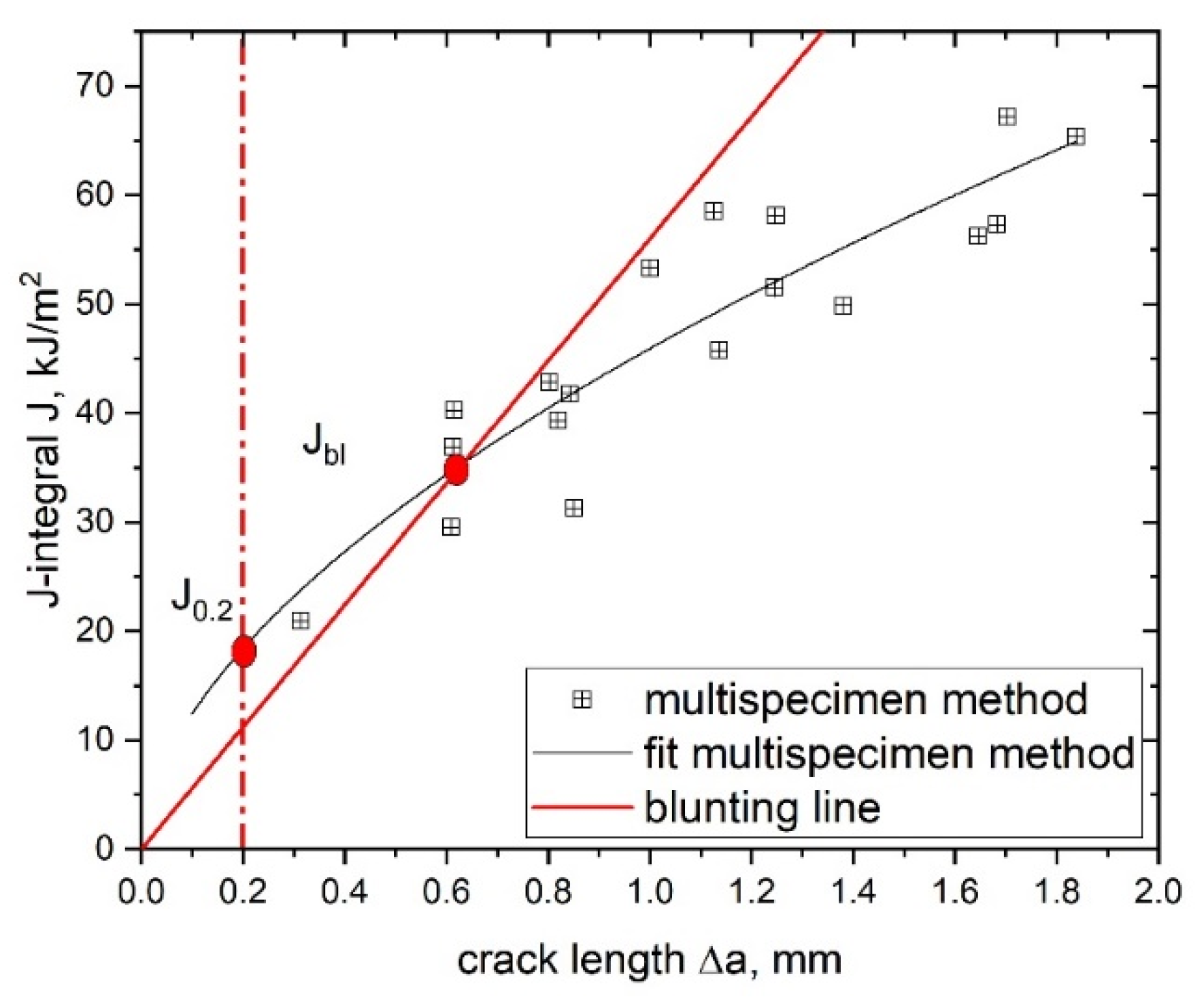




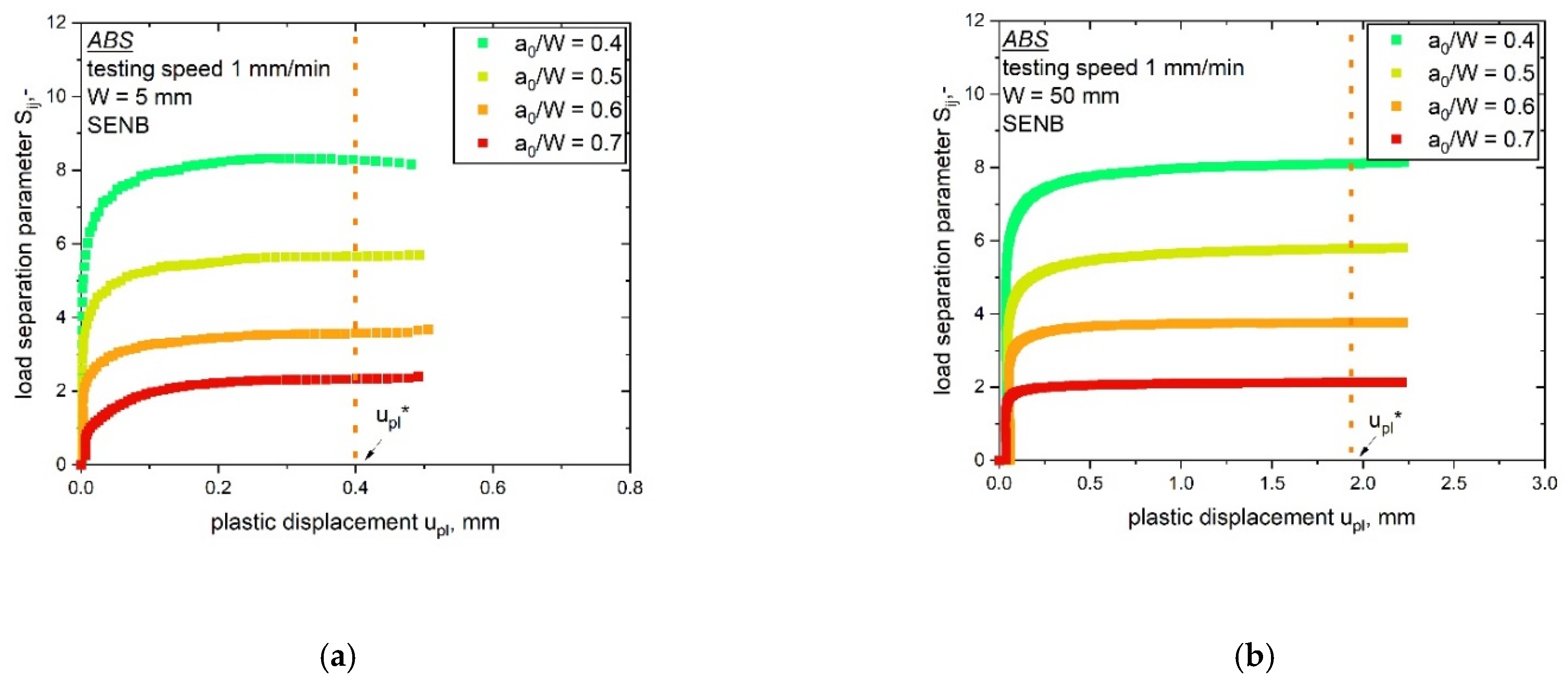
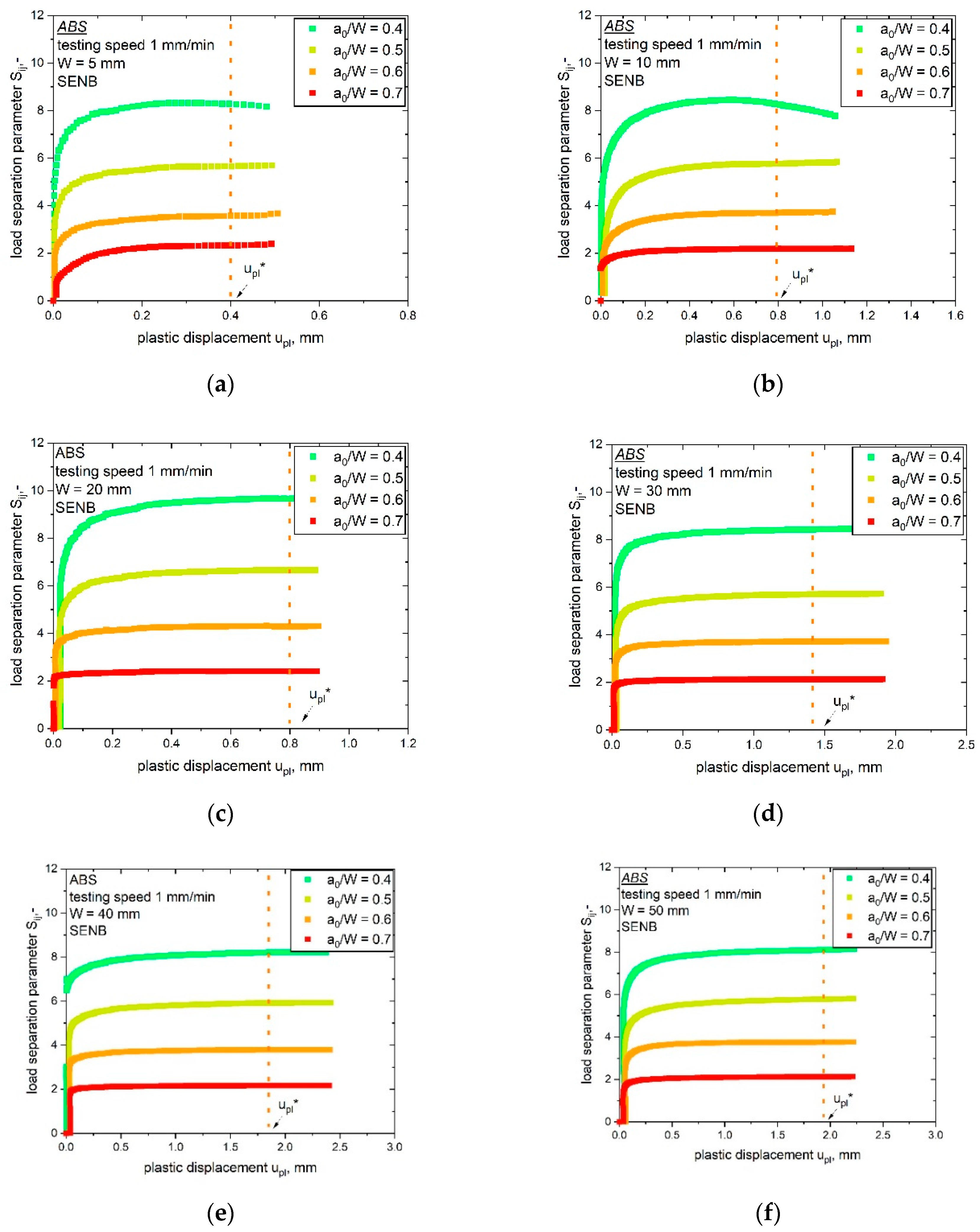
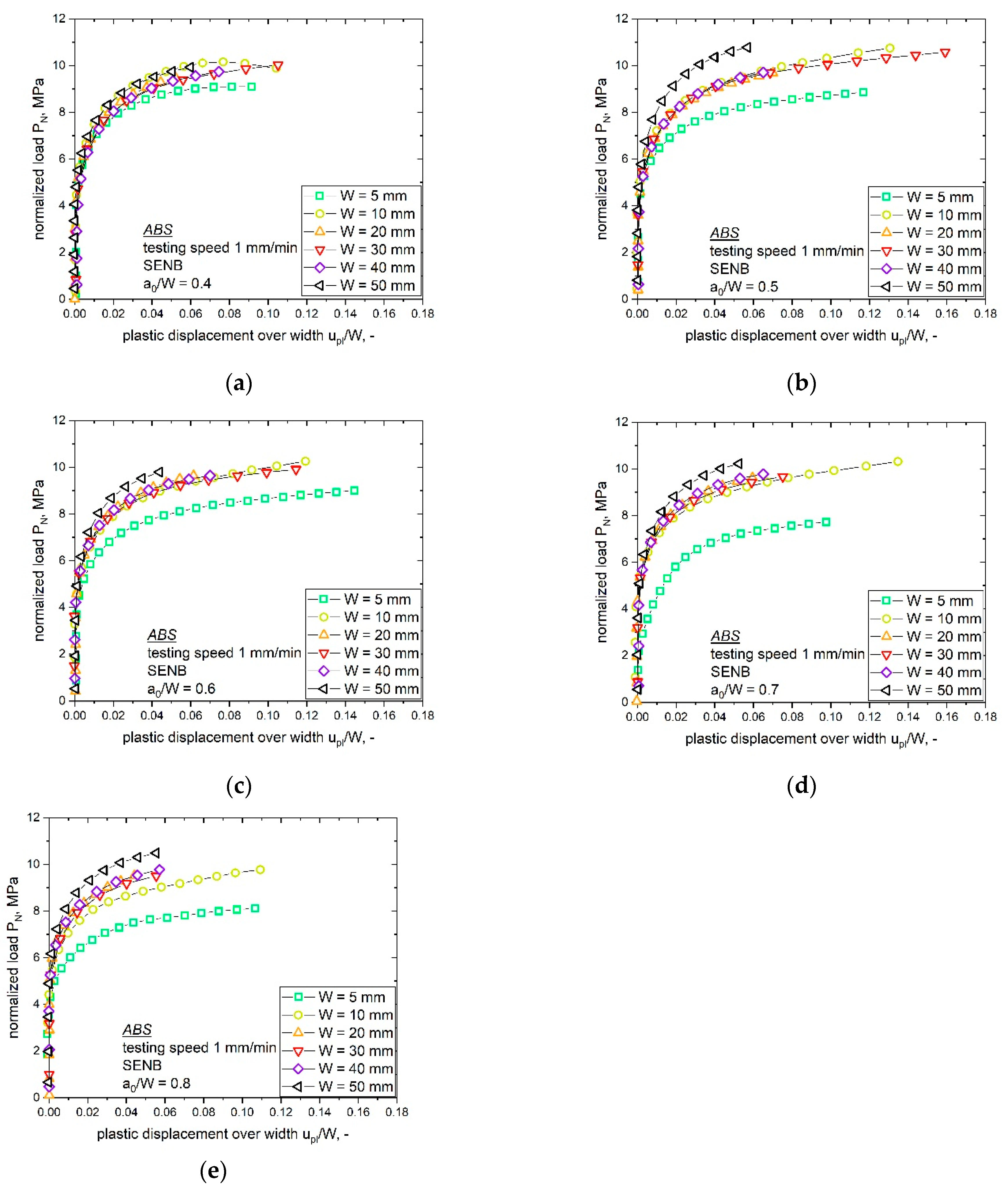
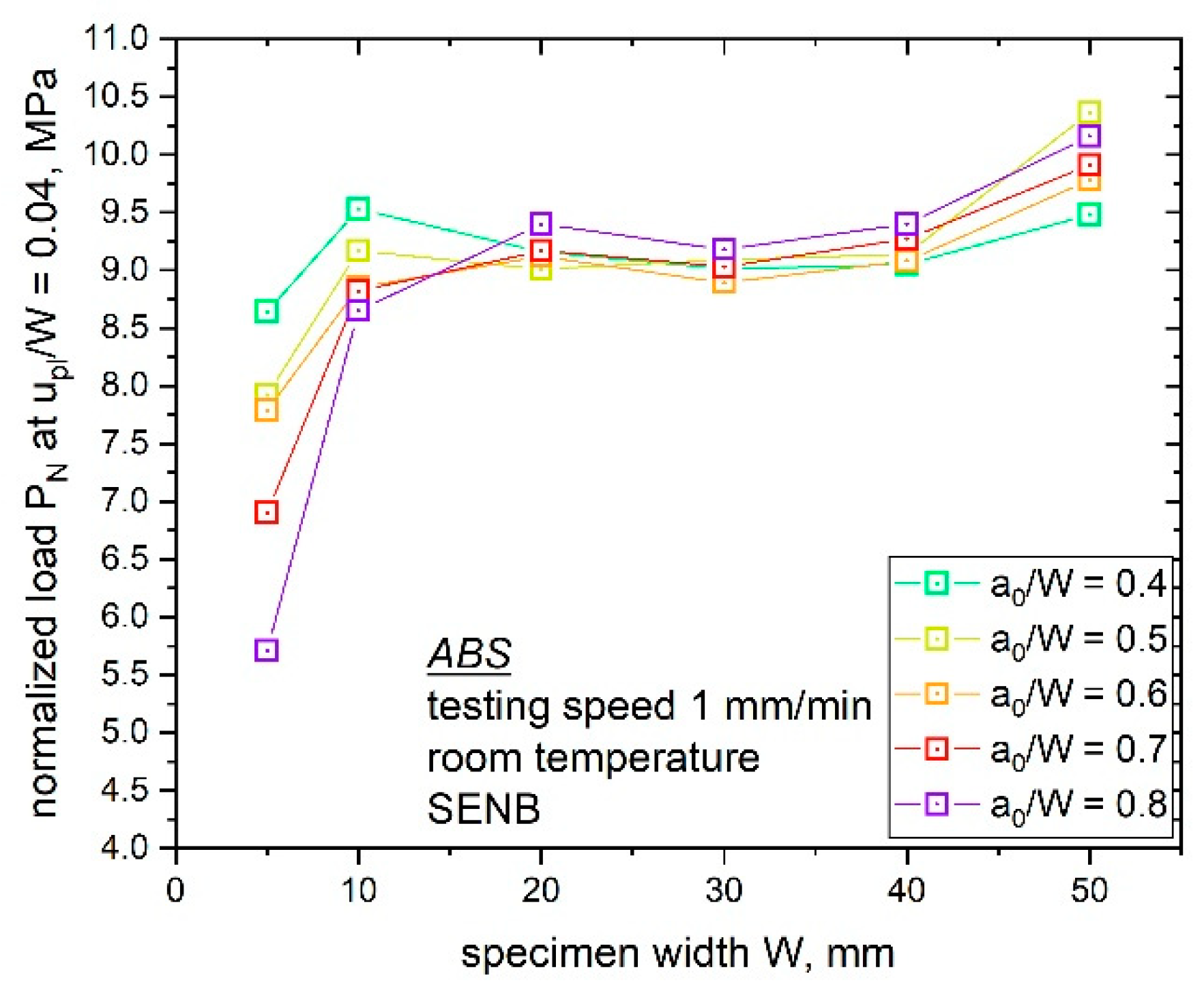
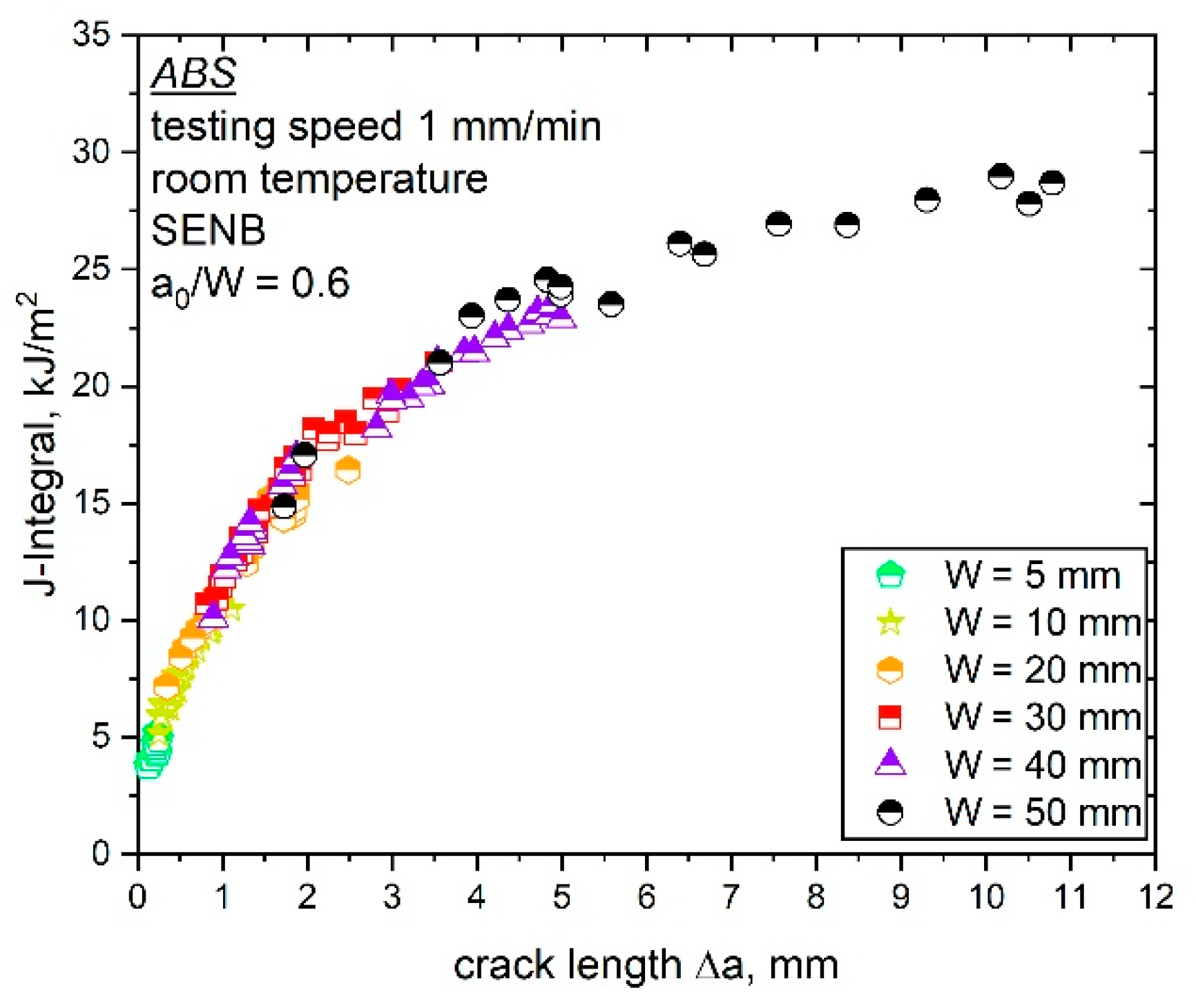

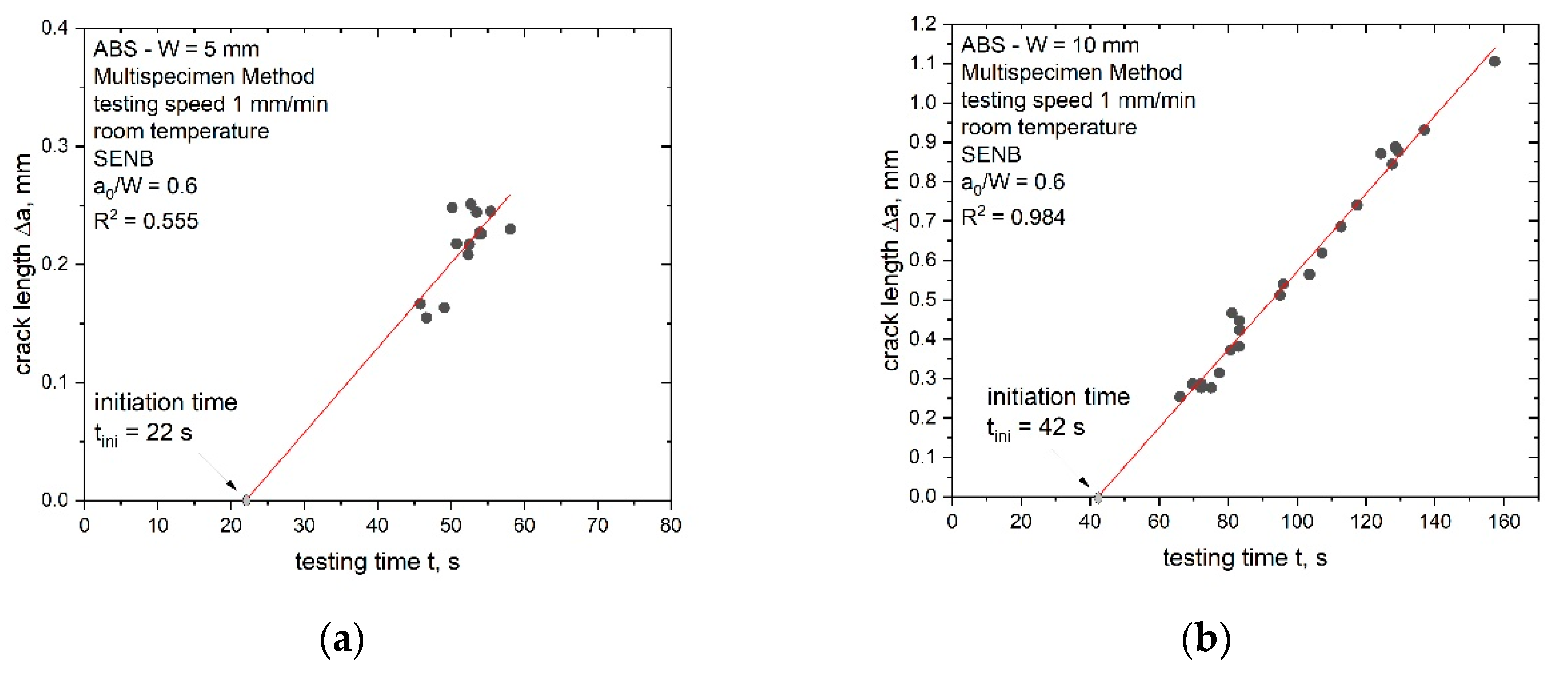
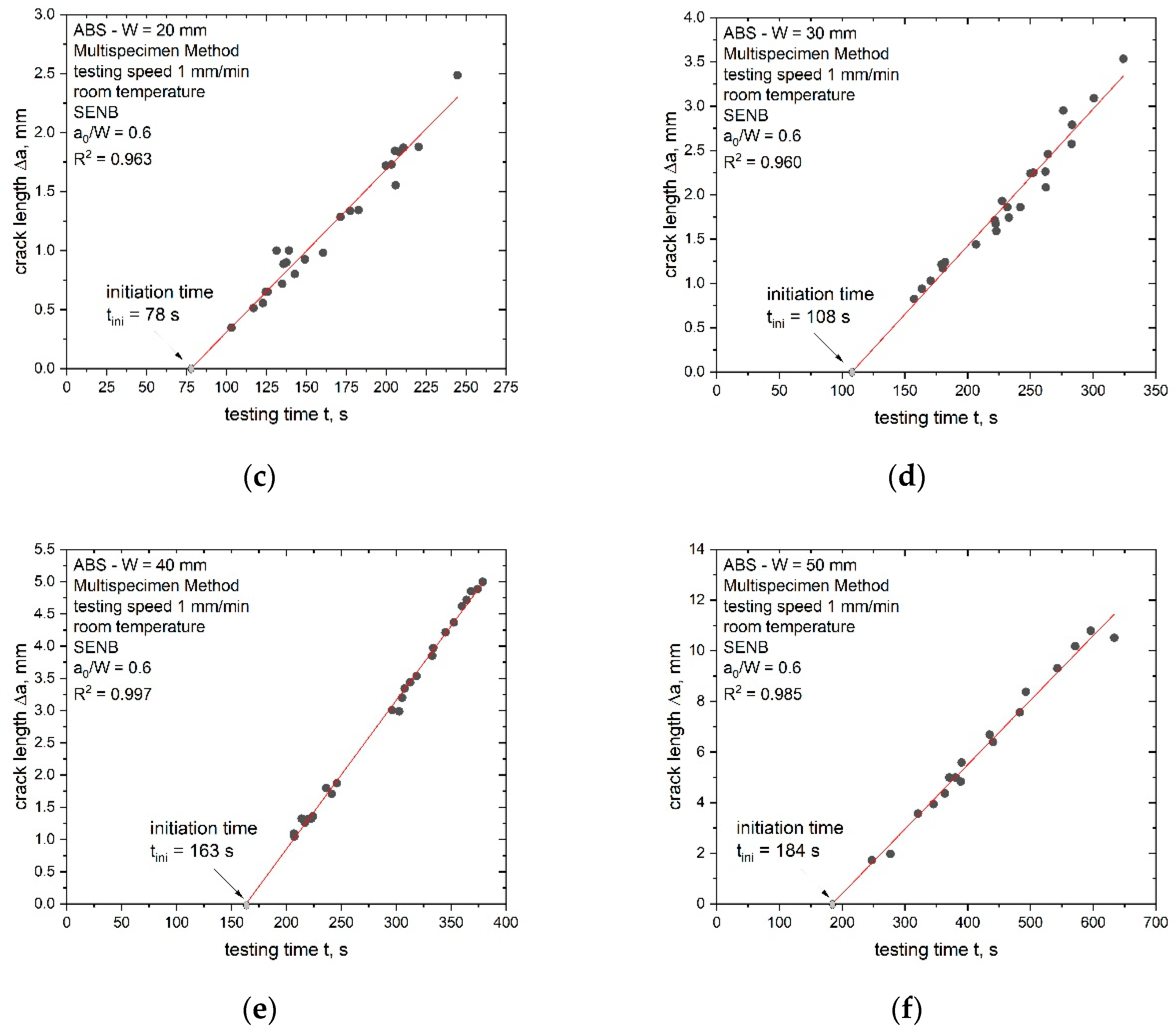
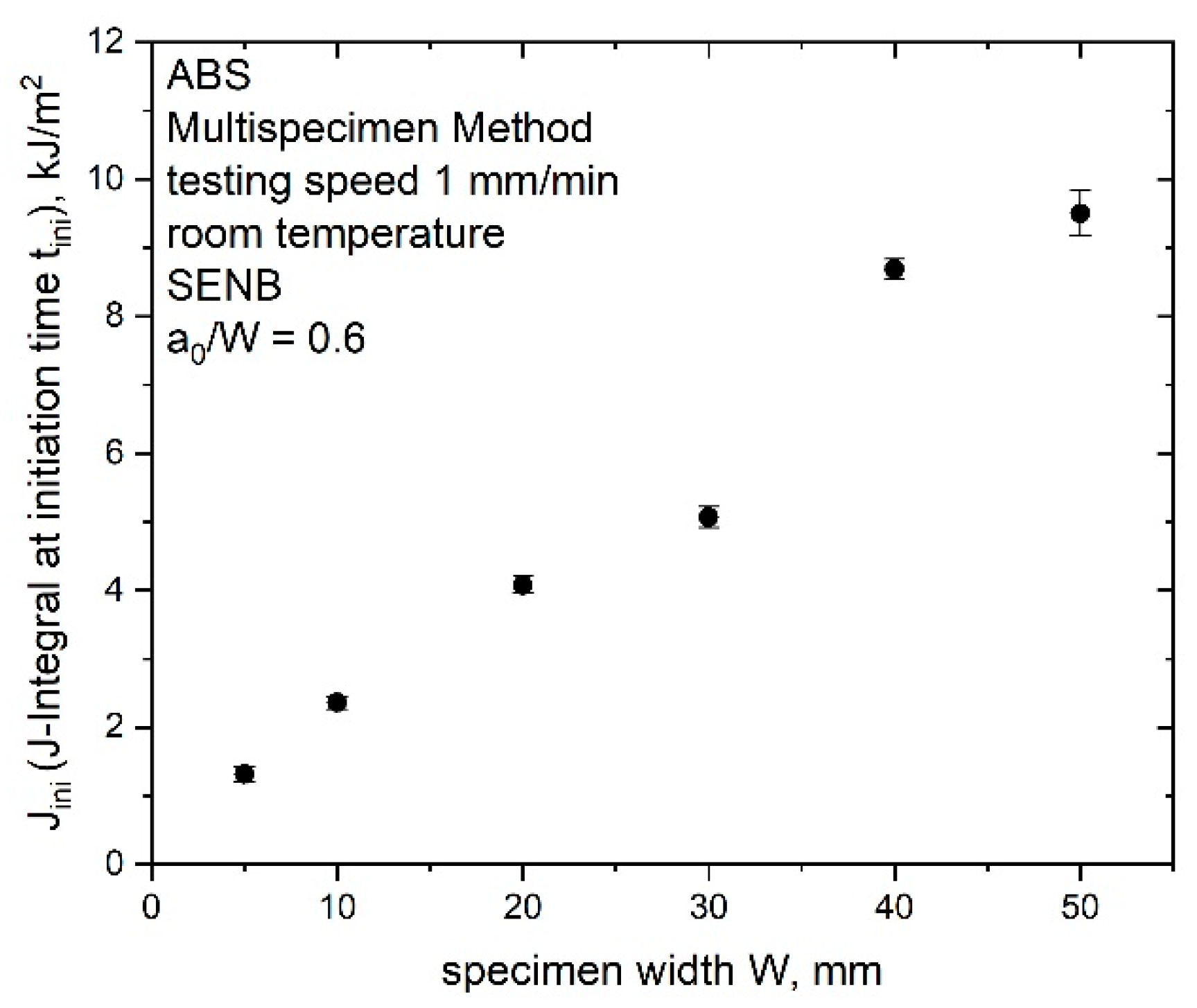

| Specimen Width W (mm) | Span Length S (mm) | Roller Radius (mm) | Load Cell Capacity (kN) | Crack Tip Radius of bN Specimen (Rtip, mm) |
|---|---|---|---|---|
| 5 | 20 | 1 | 1 | 0.5 |
| 10 | 40 | 3 | 10 | 1 |
| 20 | 80 | 3 | 10 | 2 |
| 30 | 120 | 5 | 10 | 3 |
| 40 | 160 | 5 | 10 | 4 |
| 50 | 200 | 10 | 10 | 5 |
| Specimen Width W | Parameter ηpl | R2 |
|---|---|---|
| [mm] | - | - |
| 5 | 1.98 | 0.999 |
| 10 | 2.03 | 0.999 |
| 20 | 2.03 | 0.999 |
| 30 | 2.01 | 0.999 |
| 40 | 1.94 | 0.999 |
| 50 | 1.94 | 0.999 |
| Specimen Width (W, mm) | Parameter c (Power Law Fit, kJ/(m2mmb)) | Parameter b (Power Law Fit, kJ/(m2mmb)) | R2 | Crack Initiation (J0.2, Apparent, kJ/m2) | Crack Initiation (Jbl, Apparent, kJ/m²) |
|---|---|---|---|---|---|
| 5 | 8.7 | 0.41 | 0.718 | 4.5 | 2.4 |
| 10 | 10.4 | 0.45 | 0.972 | 5.0 | 2.7 |
| 20 | 11.3 | 0.45 | 0.978 | 5.5 | 3.0 |
| 30 | 11.9 | 0.47 | 0.969 | 5.6 | 3.0 |
| 40 | 12.3 | 0.41 | 0.984 | 6.3 | 4.2 |
| 50 | 14.6 | 0.29 | 0.936 | 9.1 | 8.4 |
Publisher’s Note: MDPI stays neutral with regard to jurisdictional claims in published maps and institutional affiliations. |
© 2021 by the authors. Licensee MDPI, Basel, Switzerland. This article is an open access article distributed under the terms and conditions of the Creative Commons Attribution (CC BY) license (https://creativecommons.org/licenses/by/4.0/).
Share and Cite
Gosch, A.; Arbeiter, F.J.; Agnelli, S.; Berer, M.; Baldi, F. Size-Induced Constraint Effects on Crack Initiation and Propagation Parameters in Ductile Polymers. Materials 2021, 14, 1945. https://doi.org/10.3390/ma14081945
Gosch A, Arbeiter FJ, Agnelli S, Berer M, Baldi F. Size-Induced Constraint Effects on Crack Initiation and Propagation Parameters in Ductile Polymers. Materials. 2021; 14(8):1945. https://doi.org/10.3390/ma14081945
Chicago/Turabian StyleGosch, Anja, Florian Josef Arbeiter, Silvia Agnelli, Michael Berer, and Francesco Baldi. 2021. "Size-Induced Constraint Effects on Crack Initiation and Propagation Parameters in Ductile Polymers" Materials 14, no. 8: 1945. https://doi.org/10.3390/ma14081945
APA StyleGosch, A., Arbeiter, F. J., Agnelli, S., Berer, M., & Baldi, F. (2021). Size-Induced Constraint Effects on Crack Initiation and Propagation Parameters in Ductile Polymers. Materials, 14(8), 1945. https://doi.org/10.3390/ma14081945








